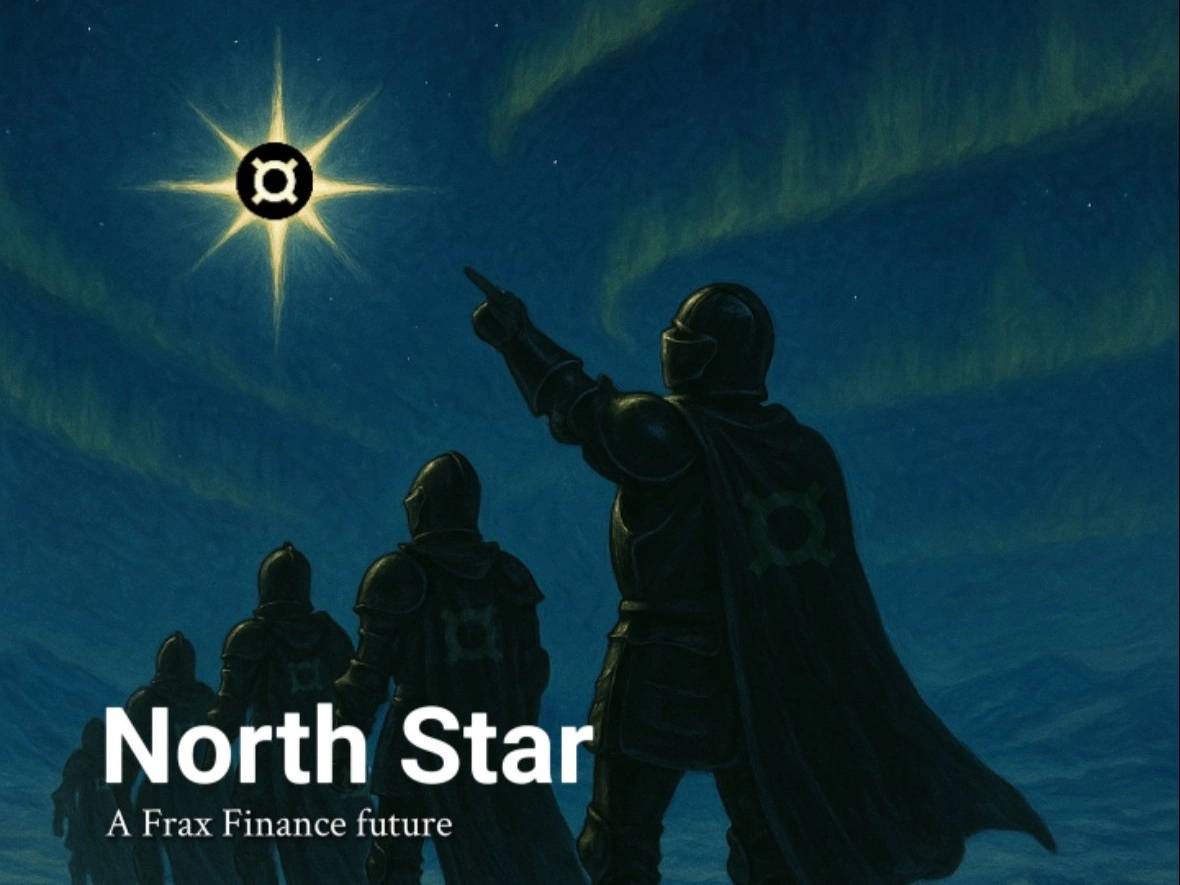North Star Hard Fork
**북극성 하드포크(North Star Hard Fork)**는 Frax Finance의 중요한 프로토콜 업그레이드로, 분권화와 지속 가능성을 높이기 위해 생태계의 거버넌스와 토큰 경제학(tokenomics)을 재구성하는 것을 목표로 합니다. 이 포괄적인 업그레이드는 Frax 아키텍처의 중요한 발전을 나타내며, 주요 과제를 해결하고 장기적인 성장을 위한 프로토콜의 위치를 확보하도록 설계되었습니다.
개요
북극성 하드포크는 Frax Finance 생태계 내에서 근본적인 문제를 해결하고 프로토콜의 미래를 위한 보다 지속 가능한 프레임워크를 구축하기 위한 전략적 이니셔티브로 등장했습니다. 2023년 말에 처음 제안된 이 업그레이드는 최종 형태에 이르기 전에 커뮤니티 피드백을 바탕으로 여러 번 반복되었습니다. [1]
하드포크는 거버넌스와 토큰 경제학에 대한 Frax의 접근 방식에 있어 중요한 변화를 나타내며, 기존의 이중 토큰 모델에서 보다 간소화되고 효율적인 구조로 이동합니다. 이러한 구조 조정은 거버넌스 비효율성을 해결하고 이해 관계자 간의 인센티브를 조정하며 프로토콜의 장기적인 생존 가능성을 위한 보다 지속 가능한 경제 모델을 만드는 것을 목표로 합니다. [2]
본질적으로 북극성 하드 포크(Fork)는 시장 피드백과 생태계 요구 사항에 따라 발전하려는 Frax Finance의 약속을 구현하며, 빠르게 변화하는 DeFi 환경에서 프로토콜의 적응성을 보여줍니다. 이 업그레이드는 Frax의 2025 비전 로드맵에서 중요한 단계로 자리 잡고 있으며, 미래의 성장과 혁신을 위한 기반을 마련합니다. [3]
주요 목표
북극성 하드포크는 다음과 같은 몇 가지 구체적인 목표를 가지고 설계되었습니다.
- 거버넌스 간소화: 더 효율적인 의사 결정 프로세스를 가능하게 하고 프로토콜 업그레이드의 마찰을 줄이기 위해 거버넌스 구조를 간소화합니다. [1]
- 토큰 경제학 재구성: 보다 지속 가능한 경제 모델을 만들고 생태계 전반의 인센티브를 더 잘 조정하기 위해 가치 축적 메커니즘을 통합합니다. [2]
- 분권화 강화: 통제 집중을 방지하고 광범위한 참여를 촉진하기 위해 이해 관계자 간에 거버넌스 권한을 보다 공정하게 분배합니다. [4]
- 프로토콜 지속 가능성: 개선된 수익 모델과 자원 배분을 통해 장기적인 프로토콜 지속 가능성을 위한 메커니즘을 구축합니다. [3]
- 생태계 성장: 프로토콜의 핵심 안정성을 유지하면서 새로운 제품과 파트너십을 통해 Frax 생태계를 확장하기 위한 기반을 만듭니다. [5]
제안의 발전
북극성 하드포크는 초기 개념에서 최종 구현에 이르기까지 상당한 발전을 거쳤습니다.
버전 1.0
초기 북극성 제안(v1.0)은 2023년 말에 Frax 커뮤니티에 소개되어 프로토콜이 직면한 근본적인 문제를 설명하고 거버넌스와 토큰 경제학(tokenomics) 모델을 재구성할 것을 제안했습니다. 이 버전은 핵심 비전을 확립했지만 상당한 커뮤니티 피드백을 받아 수정을 거쳤습니다. [1]
초기 제안의 주요 요소는 다음과 같습니다.
- 이중 토큰 모델의 거버넌스 비효율성 확인
- 예비 토큰 경제학(tokenomics) 재구성 개념
- 구현에 대한 초기 일정
- 프로토콜 지속 가능성을 위한 핵심 목표
버전 2.0
커뮤니티 논의와 피드백에 따라 이 제안은 버전 2.0(FIP-428)으로 발전하여 거버넌스 프로세스 중에 제기된 우려 사항을 해결하고 상당한 개선 사항을 통합했습니다. 이 버전은 보다 자세한 구현 계획과 명확한 경제 모델을 제공했습니다. [2]
v2.0의 주요 개선 사항은 다음과 같습니다.
- 개선된 토큰 마이그레이션 메커니즘
- 보다 자세한 거버넌스 전환 프로세스
- 이해 관계자를 위한 향상된 경제적 인센티브
- 단계적 구현에 대한 명확한 일정
- 전환 중 프로토콜 안정성을 위한 추가 안전 장치
Frax Finance의 설립자인 Sam Kazemian은 다음과 같이 언급했습니다. "북극성 하드 포크(Fork)는 Frax의 여정 전반에 걸쳐 얻은 교훈의 정점을 나타냅니다. 거버넌스를 간소화하고 인센티브를 조정함으로써 향후 10년간의 성장을 지원할 수 있는 기반을 구축하고 있습니다." [4]
기술 구현
북극성 하드포크는 프로토콜의 아키텍처를 근본적으로 변경하는 여러 기술 구성 요소를 포함합니다.
거버넌스 재구성
하드 포크(fork)는 분권화를 유지하면서 의사 결정 프로세스를 통합하는 간소화된 거버넌스 모델을 구현합니다. 여기에는 다음이 포함됩니다.
- 이중 토큰 거버넌스 모델에서 단일 토큰 구조로 전환
- 다양한 결정 유형에 대한 다른 임계값을 사용하는 계층형 거버넌스 구현
- 참여를 강화하기 위한 위임 메커니즘 도입
- 특정 프로토콜 도메인을 위한 특수 거버넌스 위원회 생성 [2]
토큰 경제학 재설계
북극성 하드 포크(Fork)의 핵심 구성 요소는 Frax의 토큰 경제학을 포괄적으로 재설계하는 것입니다.
- 단일 토큰으로 가치 축적 메커니즘 통합
- 보다 지속 가능한 발행 일정 구현
- 거버넌스 토큰(governance token)에 대한 새로운 유틸리티 기능 도입
- 프로토콜 소유 유동성 메커니즘 구축
- 이해 관계자를 위한 수익 공유 모델 생성 [3]
스마트 계약 업그레이드
구현에는 상당한 스마트 계약 업그레이드가 필요합니다.
- 새로운 거버넌스 계약 배포
- 기존 프로토콜 자산을 새로운 계약 아키텍처로 마이그레이션
- 보유자를 위한 토큰 스왑 메커니즘 구현
- 보안 모듈 및 오라클(oracle) 시스템 업그레이드
- 기존 Frax 생태계 제품과 통합 [4]
로드맵 및 구현
북극성 하드포크의 구현은 안정성을 보장하고 중단을 최소화하기 위해 단계적 접근 방식을 따릅니다.
1단계: 준비
- 기술 사양 최종화
- 새로운 스마트 계약에 대한 보안 감사
- 커뮤니티 교육 및 준비
- 마이그레이션 도구 및 인터페이스 개발 [3]
2단계: 전환
- 새로운 거버넌스 계약 배포
- 토큰 마이그레이션 기간
- 프로토콜 제어의 점진적인 전환
- 새로운 경제 메커니즘 구현 [2]
3단계: 안정화
- 매개변수 모니터링 및 조정
- 생태계 통합 완료
- 초기 성능에 따른 추가 기능 구현
- 장기적인 거버넌스 프로세스 구축 [4]
